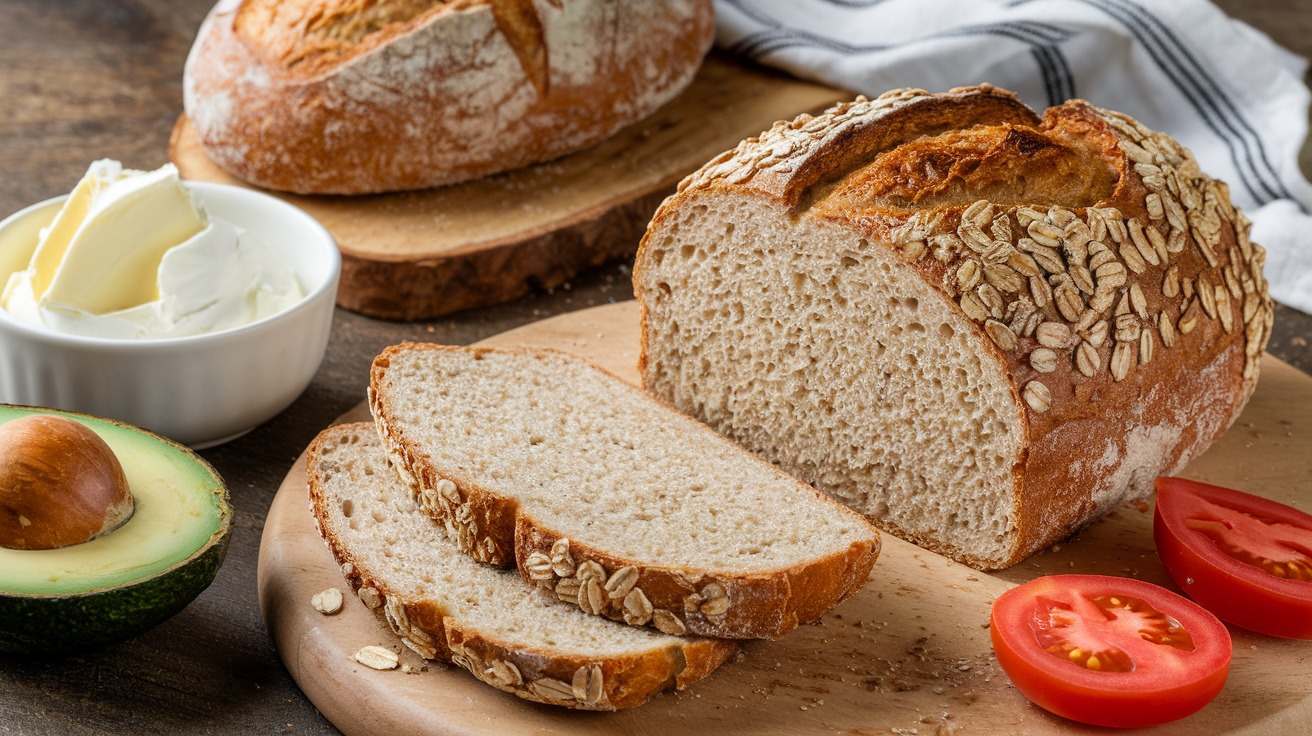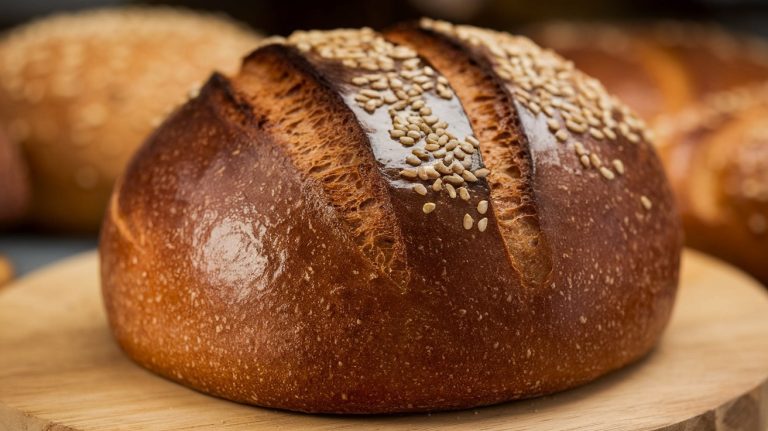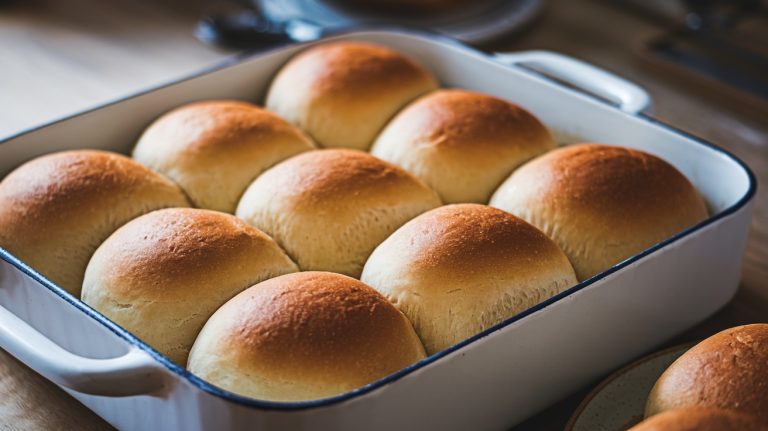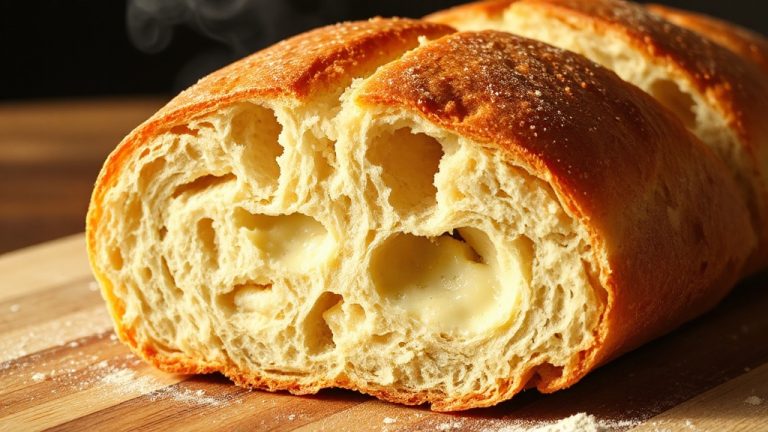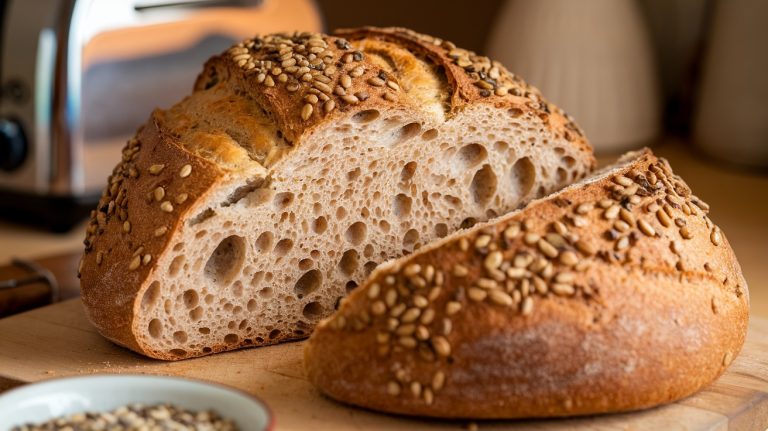Oatmeal Sourdough Bread Recipe: Delicious and Heart-Friendly
You’re about to create a fantastic oatmeal sourdough bread! Start by preparing your sourdough starter and gathering the essential ingredients like rolled oats, flour, and warm water.
Combine soaked oats with the starter, flour, and a bit of salt. Knead until the dough is smooth, then let it rise until doubled in size.
Shape your loaf and allow it to rise again before baking in a preheated oven. Enjoy the inviting aroma as it bakes to a golden crust. This bread is not just delicious; it also offers great health benefits. Stick around to uncover more tips.
Key Takeaways
- Combine 100 g cooked oat porridge and 50 g rolled oats with 325 g unbleached all-purpose flour and 75 g whole wheat flour.
- Use 100 g of bubbly sourdough starter, along with 275 g filtered water at room temperature and 315 g warm water for mixing.
- Knead the dough for 5-10 minutes to develop gluten and allow it to rise at room temperature until doubled in size (2-3 hours).
- Preheat the oven to 490°F, then bake the shaped loaf at 420°F until golden brown, checking for an internal temperature of 200°F.
- Store bread at room temperature for 1-2 days, then wrap in brown paper or a cotton tea towel for freshness.
Sourdough Starter Essentials
Creating a robust sourdough starter is the foundation of your oatmeal sourdough bread journey. Start by combining 60 g of whole wheat flour with 60 g of warm water in a clean, non-reactive container, like a glass or ceramic jar. This initial mixture should resemble a smooth, slightly thick batter.
As you nurture your starter, feed it equal parts flour and water every 12 to 24 hours, adjusting the schedule based on its storage conditions. Whole wheat flour, whole grain rye flour, and unbleached all-purpose flour are excellent choices for feeding. Quality flour impacts the flavor, texture, and fermentation of your sourdough, so choosing the right type is essential.
Keep an eye on your starter’s health; it should be bubbly and carry a slightly sour aroma. If you’ve stored it in the fridge for a while, revive it by letting it sit at room temperature for 12 hours before feeding.
Choosing the Right Oats
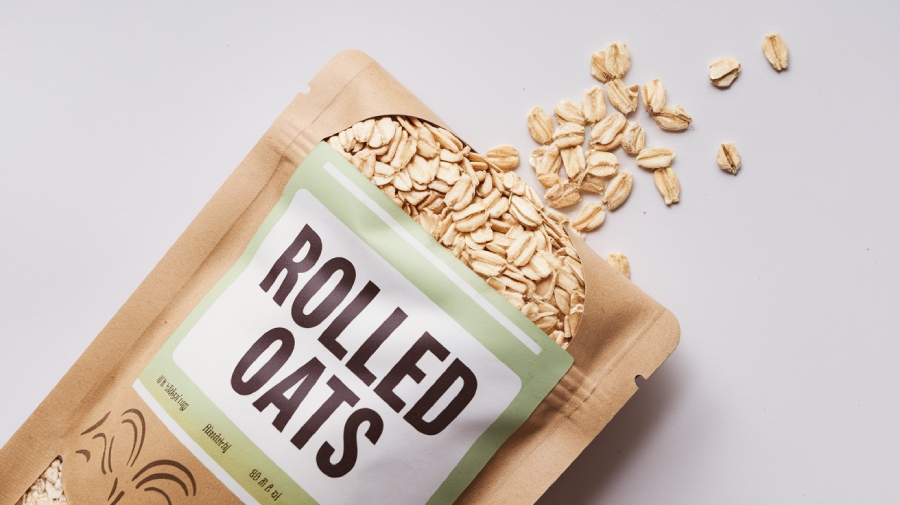
When it comes to choosing oats for your sourdough bread, understanding the differences can make a significant impact on the final product.
Quick oats might offer convenience, but old-fashioned rolled oats provide a hearty texture and robust flavor that elevate your bread. Their unique characteristics, like maintaining shape and reducing dough hydration, are essential for achieving that perfect loaf. Using high-quality ingredients ensures a better health outcome and enhances the overall taste of your bread.
Quick Oats Benefits
Choosing the right oats can greatly enhance your meals, and quick oats offer a convenient and nutritious option. Packed with essential nutrients, they’re perfect for a quick breakfast or an ingredient in your oatmeal sourdough bread.
Here are three key benefits of quick oats:
- Nutrient-Rich: With 150 calories per 40g serving, quick oats provide 27g of carbohydrates, 5g of protein, and 4g of fiber. This balance helps keep you full and energized throughout the day. Additionally, they serve as a good source of essential minerals such as calcium and magnesium that support overall health.
- Heart Health: Quick oats contain beta-glucan, which helps lower LDL cholesterol and supports heart health. Plus, they assist in managing blood sugar levels, making them an excellent choice for diabetics.
- Digestive Support: The fiber in quick oats promotes digestive health and offers prebiotic benefits, encouraging good gut bacteria.
Rolled Oats Characteristics
Rolled oats, with their distinctive flattened shape and slightly irregular discs, stand out as a versatile ingredient in many kitchens. These oats are steamed and rolled into flat flakes, allowing them to absorb water better than instant oats. This characteristic makes them perfect for baking, especially in oatmeal sourdough bread.
When choosing rolled oats for your recipes, opt for old-fashioned oats, as they retain their texture and flavor during baking. This contributes to a fuller consistency in your bread, unlike instant oats, which can result in a mushy texture with less flavor. Steel-cut oats, while nutritious, aren’t ideal for baking due to their coarse texture and limited absorption ability. Additionally, many recipes featured on the Food Network often showcase creative uses for rolled oats, highlighting their versatility in baking.
For the best results, soak your rolled oats in liquid before mixing them into your dough. This helps soften them, making them easier to incorporate. You can also grind rolled oats into oat flour to create a denser loaf, which works well for gluten-free diets.
Combining oat flour with wheat flour strikes a perfect balance, adding a delightful chewiness to your sourdough bread.
Key Ingredients and Measurements
Gathering the right ingredients is essential for creating a delicious oatmeal sourdough bread. Each component plays a crucial role in achieving that perfect texture and flavor.
Here’s a quick rundown of the key ingredients you’ll need:
- Water: You’ll need a mixture of filtered water, including 275 g at room temperature and 315 g warm water for hydration.
- Don’t forget the 225 g of room temperature milk for soaking the oats!
- Sourdough Starter: Choose from various options like 100 g of discard or a bubbly starter. You can also use rye starter or instant dry yeast if you’re in a pinch.
- Oats and Flour: For a hearty texture, include 100 g of cooked oat porridge with 50 g of old-fashioned rolled oats for coating.
- As for flour, a blend of 325 g unbleached all-purpose flour and 75 g whole wheat flour works wonders.
Step-by-Step Preparation
Now that you’ve gathered your ingredients, it’s time to jump into the step-by-step preparation of your oatmeal sourdough bread.
You’ll mix and knead the dough to create a lovely texture, then let it rise to develop that signature flavor. The fermentation process is crucial, as it allows the dough to develop a unique flavor profile that sets sourdough apart from regular bread.
Finally, you’ll shape and bake it to perfection, filling your kitchen with the irresistible aroma of fresh bread.
Required Ingredients Overview
Preparing the ingredients for your oatmeal sourdough bread is an essential step that sets the foundation for a delicious outcome.
Ensuring you have the right components ready to go will streamline your baking process and enhance the flavor of your bread.
Here’s what you need to gather:
- Sourdough Starter: You’ll need 2 cups of rye sourdough starter to kickstart the fermentation process. Make sure it’s active and bubbly!
- Flour Mixture: Combine 3 cups of unbleached all-purpose flour with 1 ¾ cups of bread flour and 90 grams of whole wheat flour. This blend gives your bread a perfect texture.
- Liquid and Oats: You’ll want 1-1 ¼ cups of lukewarm milk and 1 ½ cups of rolled oats. Soak the oats in water beforehand to soften them, ensuring they mix well with the dough. Whole grain flour can replace a portion of bread flour, contributing to flavor and nutrition.
Mixing and Kneading Techniques
With your ingredients ready, it’s time to bring them together through careful mixing and kneading techniques. Begin by combining your sourdough starter with water in a glass or ceramic bowl, ensuring the starter dissolves completely. Add your flour, oatmeal, and salt to this mixture, stirring until you form a sticky dough ball. If you’re using a Thermomix, the kneading will chop the oats beautifully without needing additional equipment.
Next, let the dough rest for 30-60 minutes to develop a sponge before kneading. If you’re kneading by hand, incorporate as much flour as possible initially, finishing with the remaining flour while adding milk and oats. Knead the dough for 4-5 minutes until it pulls away from the bowl’s sides and gathers on the hook. This process is crucial for achieving the right gluten development that contributes to the bread’s structure.
For ideal texture, consider soaking the oats in boiling water for at least five minutes before mixing them in. You can also stretch and fold the dough to incorporate the oats evenly.
Rising and Baking Process
The dough, having rested and developed its flavor, is ready for the rising and baking process, which transforms it into the perfect loaf. Start by shaping your dough into a rectangle and rolling it up into a loaf. Place it in a pan, cover it, and let it rise at room temperature until it doubles in volume—this usually takes about 2-3 hours. Understanding the importance of proofing can enhance the outcome of your bread, as it significantly affects the dough’s texture and flavor.
Here’s what to do next:
- Cold Fermentation: For deeper flavor, refrigerate the shaped dough for 2-3 days, allowing it to slowly ferment. This process promotes ideal hydration levels that contribute to a more complex taste.
- Scoring: Just before baking, cut a slash down the center of the loaf to help it expand evenly in the oven.
- Baking: Preheat your oven to 490°F, then reduce it to 420°F after scoring. Bake the loaf covered for 30 minutes, then uncover and bake for an additional 7 minutes until it reaches an internal temperature of 200°F.
Baking Your Bread
As you gear up to bake your oatmeal sourdough bread, it’s crucial to guarantee your dough is ready for its moment in the oven. After allowing it to rise until it doubles in size, preheat your oven to 350°F.
While you’re waiting, remove your dough from the refrigerator and gently turn it out onto a lightly floured surface. Shape it into a rectangle, rolling from the long side to create a log. Pinch the seam closed and place your dough seam side down in a greased loaf pan. Cover it with plastic wrap or a damp tea towel and let it proof for 1-2 hours. A properly maintained sourdough starter is essential for achieving the desired dough rise.
Once your dough has risen to about 3/4″ – 1″ above the pan’s lip, it’s time to bake. Before placing it in the oven, brush the top with an egg wash and sprinkle with oats for that beautiful finish. Remember that the bread incorporates whole grains and protein-rich ingredients, which enhances its nutritional benefits.
Bake for 40-55 minutes, rotating the loaf halfway through for even browning. The bread is done when it reaches an interior temperature of 200°F.
After baking, let the loaf cool in the pan for 5 minutes before transferring it to a cooling rack, allowing the aroma to fill your kitchen. Enjoy!
Recipe Variations to Try
Explore a world of flavors by trying out various recipe variations for your oatmeal sourdough bread. You can elevate your baking game by experimenting with different grains, fruits, and spices. Here are three delightful variations to contemplate:
- Honey Oat with Rye: Replace 100g of bread flour with 100g of rye flour for a rich, earthy flavor that pairs beautifully with the sweetness of oats. This variation not only adds depth but also enhances the nutritional value of the bread.
- Dried Fruit and Nuts: Add 75g of chopped dried apricots or cranberries during the stretch and fold phase. This addition not only enhances sweetness but also provides a chewy texture that makes each bite delightful.
- Herb and Cheese Twist: Mix in Italian herbs and good-quality cheese, like cheddar or parmesan, to create a savory loaf that’s perfect for sandwiches or as a snack.
Each variation offers a unique taste and texture, allowing you to personalize your oatmeal sourdough bread.
Tips for Perfect Bread
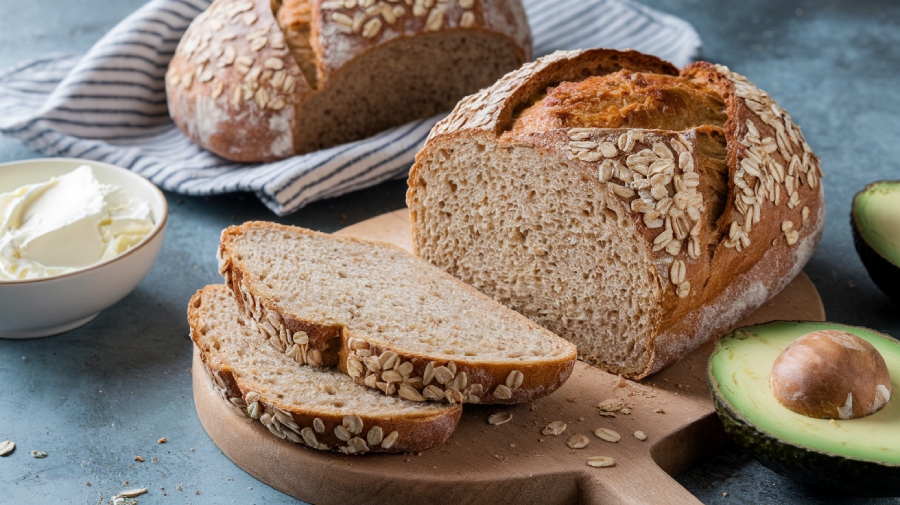
Achieving perfection in baking oatmeal sourdough bread requires attention to detail and a few essential techniques. Start by mixing your ingredients correctly: place flour in the bowl first, then salt and yeast on opposite sides. Add fat and three-quarters of the water, mixing until a soft dough forms. Knead the dough for 5-10 minutes, stretching and folding it until it’s smooth and elastic. Kneading is essential for developing gluten to create elastic dough. Additionally, incorporating high-hydration dough techniques can enhance the final texture of your bread.
When it comes to rising, let your dough sit in a lightly oiled bowl until it doubles in size, which usually takes about 60-90 minutes. Afterward, gently knock it back and shape it as desired. Using a fed, bubbly sourdough starter is crucial for excellent fermentation.
Pay attention to hydration levels; high moisture is key for oatmeal sourdough. Incorporate whole and chopped oats at different stages for texture improvement. For best results, opt for quality bread flour and high-quality rolled oats, steering clear of steel-cut or instant varieties.
Finally, don’t forget to score your loaf before baking. A good score allows the bread to spring beautifully in the oven, enhancing both its appearance and texture. Scoring also helps control dough expansion, which is vital for achieving the perfect crust.
Common Mistakes to Avoid
Even with the right techniques in place, mistakes can easily derail your efforts to bake perfect oatmeal sourdough bread. To help you navigate the process, here are some common pitfalls to avoid:
1. Inadequate Oat Incorporation
Ensure you’re using the right type of oats and properly hydrating them before adding to the dough. Missteps here can lead to uneven texture and flavor.
2. Incorrect Proofing
Proofing times are essential. Keep an eye on your dough and use the poke test to check for readiness. Overproofing can result in a flat loaf, while underproofing leaves it dense.
3. Overmixing and Gluten Issues
Overmixing can ruin your dough structure. Allow for adequate rest during autolyse and perform gentle stretch and folds to develop gluten properly. Additionally, be mindful of your bulk fermentation times to ensure optimal dough rise and texture.
Health Benefits of Oatmeal Sourdough
The remarkable health benefits of oatmeal sourdough bread make it a standout choice for anyone looking to enhance their diet. Packed with essential nutrients, this bread not only satisfies your taste buds but also supports your well-being.
Here are three key benefits you’ll love:
1. Rich in Fiber and Protein: Oatmeal sourdough is a fantastic source of fiber, promoting healthy digestion and a balanced gut.
Plus, its moderate protein content helps keep you feeling full longer.
2. Lower Glycemic Index: Thanks to the lactic acid bacteria, oatmeal sourdough has a Lower Glycemic Index, making it easier on your blood sugar levels.
You’ll experience stable energy without the sugar spikes common with other breads.
3. Nutrient-Dense: This bread is loaded with vitamins and minerals, including folate and potassium, which are crucial for muscle function and overall cellular health.
Frequently Asked Questions
Can I Use Instant Oats Instead of Rolled Oats?
You can use instant oats instead of rolled oats, but it’s not recommended for baking.
Instant oats are finer and can result in a drier, less textured loaf. If you want that chewy, hearty feel in your dishes, stick with rolled oats. They hold up better in baking, providing a satisfying texture.
If you’re in a pinch, consider chopping rolled oats to mimic instant oats, but expect some differences in texture and moisture.
How Do I Know if My Sourdough Starter Is Active?
To know if your sourdough starter’s alive and kicking, look for some telltale signs.
It should double in volume within 4-6 hours, boasting a pleasant, yeasty aroma. You’ll spot bubbles breaking on the surface, and it should feel thick, like warm peanut butter.
Try the float test; a spoonful should bob on water if it’s at its peak.
Keep an eye on these details, and you’ll bake with confidence!
Can I Substitute Oil for Butter in the Recipe?
You can’t simply substitute oil for butter in baking.
While oil keeps things moist and adds a different texture, it lacks the leavening power that butter provides.
Butter adds richness and creates that tender crumb you love, while oil leads to a denser result.
If you decide to switch, adjust your expectations for flavor and texture.
Always follow the recipe’s fat recommendation for the best outcome in your baking adventures!
Is It Necessary to Use Eggs in Oatmeal Sourdough Bread?
You might think eggs are the secret ingredient that transforms bread into a culinary masterpiece, but in traditional oatmeal sourdough, they’re more like a mere distraction.
Most recipes thrive without them, embracing a pure, rustic flavor. Sure, some might add eggs for extra richness, but you’ll find that the classic method keeps things simple and delicious.
How Can I Tell When My Bread Is Fully Baked?
To tell when your bread’s fully baked, look for a golden brown crust and a firm texture.
Tap the bottom; it should sound hollow. Feel its weight; a fully baked loaf feels lighter.
Check the internal temperature with a thermometer; it should be at least 200°F.
Alternatively, insert a toothpick into the center—if it comes out clean, you’re good to go!
Trust your instincts and practice to refine your baking skills!
A Bread That’s as Good for You as It Tastes
Incorporating oatmeal into your sourdough not only adds a delightful texture but also boosts its nutritional value. Did you know that oat fiber can help lower cholesterol levels by up to 10%?
By following this recipe, you’re not just baking bread; you’re creating a wholesome loaf that’s as beneficial as it is delicious. So, enjoy the process, and savor each slice knowing you’ve crafted something truly special for both your taste buds and your health.

